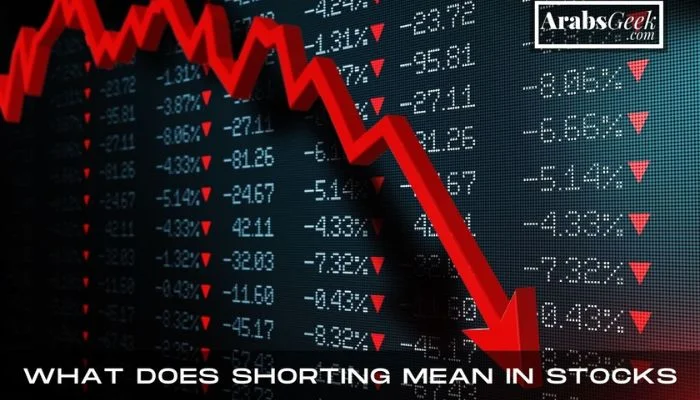Introduction
For many, the stock market is a place of opportunity and wealth creation, often associated with buying and holding stocks, expecting them to increase in value over time. This traditional investing method is known as “going long.” But did you know there’s another trading strategy that allows you to profit even when the market is falling? This strategy is called “short selling” or “shorting,” and it involves betting against a stock. Let’s dive into what shorting means in stocks and explore its risks, benefits, and more.
Table of Contents
Understanding Short Selling
What is Short Selling? | What Does Shorting Mean in Stocks
In simple terms, short selling is an investment strategy where an investor borrows shares of a stock from a broker and sells them in the open market, intending to buy them back later at a lower price. The investor profits from the difference between the selling price and the buying price if the stock’s price falls as anticipated.
For any business enquiry, you can contact us at ArabsGeek.com
For more of such financial articles, Consider visiting our sister website at EntrepreneursPilot.com
How Does Short Selling Work?
To initiate a short sale, an investor first opens a margin account with their broker. This account allows the investor to borrow shares for short selling. The investor then sells the borrowed shares on the open market at the current price.
If the price of the shares falls, the investor can buy them back at the lower price, return the borrowed shares to the broker, and keep the difference as profit. However, if the price rises, the investor must purchase the shares at the higher price, resulting in a loss.
The Risks of Short Selling
Unlimited Loss Potential
Unlike traditional investing, where the maximum loss is the amount invested, short selling carries potentially unlimited loss potential. If the stock price increases instead of falling, the losses can exceed the original investment.
Short Squeeze | What Does Shorting Mean in Stocks
A short squeeze occurs when a heavily shorted stock’s price begins to rise sharply. This forces short sellers to buy the stock back at higher prices to limit their losses, which further drives up the stock price.
Regulatory Risks
Short selling is subject to numerous regulations. For instance, the “uptick rule” requires that short sales are only executed at a higher price than the previous trade. Additionally, if a stock becomes difficult to borrow for short selling, the investor could be subjected to a forced buy-in.
The Potential Benefits of Short Selling
Profit from Market Declines
The primary advantage of short selling is the potential to profit from a decline in a stock’s price. This is contrary to traditional investing, where profits are made from price increases.
Hedging | What Does Shorting Mean in Stocks
Short selling can also serve as a hedging strategy. For example, an investor can short a stock to offset potential losses from a long position in a similar stock.
Short Selling vs. Long Buying
While traditional long buying aims to profit from rising stock prices, short selling does the exact opposite. It’s essentially a wager against a stock, with the investor betting that the stock’s price will drop.
Examples of Successful Short Sales
The Housing Market Crash of 2008
One of the most famous examples of successful short sales occurred during the 2008 financial crisis. Several investors, including hedge fund manager John Paulson, made billions by short selling subprime mortgage-backed securities.
The Ethics of Short Selling
Short selling often sparks ethical debates. Critics argue that short sellers can spread negative rumors about a company to drive down its stock price. However, proponents contend that short selling provides liquidity, contributes to efficient pricing, and exposes corporate fraud.
How to Short a Stock | What Does Shorting Mean in Stocks

Find a Suitable Stock
Not all stocks are suitable for shorting. Look for stocks that, based on your research, are overvalued or poised to drop in price.
Open a Brokerage Account
You’ll need to open a margin account with a broker to borrow shares for short selling. It’s important to understand the broker’s terms and fees associated with short selling.
Place a Short Sell Order
Once you’ve identified a stock to short, place a short sell order through your broker. This involves specifying the number of shares you wish to short and the price at which you want to sell.
Close the Position | What Does Shorting Mean in Stocks
After the stock price falls (hopefully), you can buy the shares back at the lower price, return the borrowed shares to your broker, and pocket the difference. To do this, you place a buy-to-cover order with your broker.
Tips for Short Selling
Start with a Stop Loss
A stop-loss order can limit potential losses from a short sale by automatically triggering a buy-to-cover order if the stock’s price reaches a certain level.
Research, Research, Research
Successful short selling requires diligent research to identify stocks that are likely to decline in price. It’s also essential to stay informed about news and trends that could impact your short positions.
Stay Updated | What Does Shorting Mean in Stocks
Monitor your short positions regularly and be ready to act quickly if the market moves against you. Remember, prices can change rapidly, and the potential losses from short selling are theoretically unlimited.
Conclusion | What Does Shorting Mean in Stocks
In conclusion, short selling is a sophisticated trading strategy that involves substantial risk but also offers the potential for significant profits. By thoroughly understanding how short selling works, its risks and benefits, and the mechanics of initiating a short sale, you can make more informed decisions and potentially incorporate short selling into your investing toolkit.
Frequently Asked Questions (FAQs)
Q1. Can anyone short a stock?
Anyone with a margin account with a brokerage firm can potentially short a stock. However, not all stocks can be shorted, and some brokers may impose additional requirements.
Q2. What happens if I cannot return the borrowed shares?
If you cannot return the borrowed shares because the stock is no longer available or you can’t afford to buy them back, your broker can force you to close your position. This is known as a forced buy-in.
Q3. What does it mean when a stock is heavily shorted?
A heavily shorted stock has a large number of its shares borrowed for short selling. This could indicate that many investors believe the stock’s price will decline.
Q4. Can short selling lead to market manipulation?
There are concerns that short selling can be used to manipulate markets by spreading negative rumors about a company to drive down its stock price. However, such practices are illegal.
Q5. What is a short squeeze?
A short squeeze is a rapid increase in the price of a stock that has been heavily shorted. It forces short sellers to buy the stock back at higher prices to limit their losses, which can further drive up the stock price.











